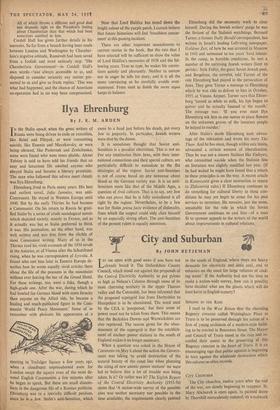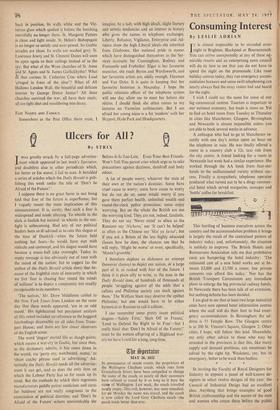CITY CHURCHES
The City churches, twelve years after the end of the war, are slowly beginning to reappear. St. Mary Abchurch is open again, its painted dome by Thornhill miraculously restored, its woodwork back in position, Its walls white and the Vic- torian glass which spoiled it before the bombing mercifully no longer there. St. Margaret Pattens is clean and light inside. St. Helen's Bishopsgate is no longer so untidy and over-pewed. Its Gothic arcades are clean. Its walls are washed grey. St. Lawrence Jewry and St. Clement Danes will soon be open again to their ceilings instead of to the sky. But what of the Wren churches of. St. Anne and St. Agnes and St. James Garlickhythe? What af -that curious St. Catherine Cree where Laud `cringed in front of the altar'? What of All Hallows London Wall, the beautiful and delicate interior by George Dance Junior? All these churches survived the war; all have their roofs; all are tight shut and mouldering into decay.
FAIR NAMES AND FAMOUS
Somewhere in the Post Office there must, I imagine, be a lady with high ideals, slight literary and artistic tendencies and an interest in history who gives the names to telephone exchanges. Liberty, Reliance, Vigilance, Enterprise and Ad- vance show the high Liberal ideals she inherited from Gladstone. Her national pride in names which have distinguished themselves in the Ser- vices accounts for Cunningham, Rodney and Fremantle and Frobisher. Elgar is her favourite musician, she reads Byron and Wordsworth, and her favourite artists are, oddly enough, Flaxman and Van Dyke. It is quite in keeping that her favourite historian is Macaulay. I hope the public relations officer of the telephone system will one day allo'w me to meet her before she retires. I should think she often comes to my lectures on Victorian architecture. But I am afraid her young niece is a bit 'modern' with her Skyport, Hyde Park and Headquarters.































 Previous page
Previous page